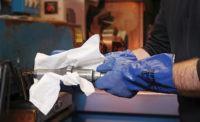How to handle temperature & labor stressors

Many workers and outdoor enthusiasts’ are exposed to temperature extremes throughout the day. Most of the time this is due to work, exercise or in my case, a circulatory disorder which can make me sweat profusely. My core temperature will suddenly drop, forcing my body to overcompensate by elevating and supercharging my body temperature which results in overheating. Living in a part of the world with massive temperature swings from -4˚F in the winter to 95˚F in the summer does not help me either, and is the primary reason that I began my research into resolving heat stress.
Over-taxing the body
Heat stress arises from a variety of both environmental and physical elements. It can be due to extreme outdoors temperature, lack of climate controlled environments and wearing apparel that doesn’t breathe, to over-taxing the body until it exhausts itself, which can lead from mild discomfort to death.
Heat exhaustion is not only our body’s way of informing us that we are not cooling down properly, but an indicator of how much it can impact productivity. Back in 1968, NASA's heat stress report CR-1205 found that temperatures over 80°F have a marked NEGATIVE effect on both the productivity and accuracy of work. At 95°F the report showed that study participants were found to make 60 mistakes per hour. That's one mistake every minute. That report is still used today by safety teams to create optimal work environments.
When compounding high heat with intense physical labor or exercise, the body cannot effectively regulate blood flow to the surface of the skin to dissipate the heat. In order to compensate, the body will begin to increase the sweat levels, thereby exhausting excess heat, but at the same time losing fluids that need to be replenished. Failure to do so often results in loss of strength, nausea, headaches or even worse.
When the body can’t keep up
If the body is unable to regulate and cool itself, it will begin to store heat (overheat), and like a car engine, it will begin to stall, resulting in something as simple as a loss of concentration that can quickly escalate to a total loss of consciousness.
In today’s work environment, it is difficult to remove the mitigating factors without severely altering the corporate bottom line. Here are some cost effective ways how to do it:
- Know your body. Sounds easy enough, but we often push ourselves beyond a safe threshold, resulting in anything from a minor scrape to a full blown catastrophe. If you feel like you need to stop, then stop.
- Hydrate. You don’t need to drink eight cups of water a day to be healthy. You simply need to drink when you are thirsty. However, if you know that there is a possibility of heat stress exposure, then you should pre-emptively drink before your body craves fluids.
- Wear the right clothing for the job. Technology developments in cooling fibers, yarns, fabrics and apparel help maintain and regulate your core temperature and are engineered to keep your body cool even as you heat up. When choosing the appropriate apparel, do your research and make sure the company has proven scientific data, by independent labs and not just a cool tag line.
- Acclimatise to the heat. If the high heat temperatures are new to you, get used to them slowly rather than jumping in full throttle. Your body needs to be given the opportunity to regulate itself and it cannot do so on a whim. A reduced workload and exposure at the beginning will benefit in the long run.
- You can overheat in cold weather. Layering is a necessity in colder climates, but poor moisture management will cause your body to overheat due to the excess humidity created between the layers of clothing. Most winter clothing is not very breathable. Wet clothes can also freeze, causing even more discomfort. Use a cooling base layer to pull the moisture away from your skin and distribute it though the fabric, thereby reducing humidity along with managing the sweating, freezing pendulum.
New protocols
Increased awareness has guided many companies to take positive steps and implement new protocols revolving around rest and hydration, purchase fans and cooling apparel and worker education. Since we all handle and react differently to heat stress we need to look at new proven technology to help protect ourselves and of course use common sense. Heat stress can happen quickly if you’re not prepared so be aware of your environment, your activity level and your body’s ability to stay cool.
Looking for a reprint of this article?
From high-res PDFs to custom plaques, order your copy today!





